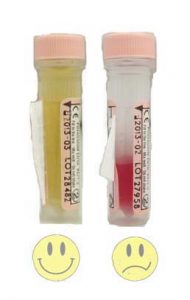Ron Hines DVM PhD
 See What Normal Blood & Urine Values Are
See What Normal Blood & Urine Values Are
 Causes Of Most Abnormal Blood & Urine Tests
Causes Of Most Abnormal Blood & Urine Tests
The Hemolysis Index Of Your Dog Or Cat’s Blood Sample
Hemoglobin (Hb), the red pigment that carries oxygen, belongs in your dog or cat’s red blood cells (erythrocytes). When this pigment escapes into solution during or after a blood sample is collected, the sample is said to be hemolyzed. When it escapes while still in the blood stream, a process called intravascular hemolysis has occurred.
The second cause is quite rare – but both conditions when substantial can falsely alter some of your pet’s other blood test results. Some of those altered values can be adjusted to correct the value using mathematical formulas. But it is always wise to have a new non-hemolyzed sample from your dog or cat resubmitted. Misleading results that are possible due to a hemolyzed blood samples include elevated levels of potassium, phosphate, CK, AST, LDH, uric acid and magnesium and decreased levels of AP, amylase and GGT.
Reasons Why Your Pet’s Blood Sample Might Be Reported By The Lab As Hemolyzed:
Ninety percent of the time, the problem was due to the blood sample being collected too fast, too slow, with too much suction on the syringe plunger or through too narrow a needle.
All animal hospitals get busy with unexpected emergencies. Veterinarians and their staff are human, so they get stretched thin at times.
Too long a period sitting at room temperature between the time the sample was obtaining and the time it was analyzed can also cause hemolysis. So can accidentally freezing the sample.
The veins of small pets can be quite difficult to withdraw blood from – particularly when the pet has health problems that decrease blood pressure. When a vein has been tapped many times before or when your pet is squirmy obtaining a non-hemolyzed blood sample can be a challenge. In those dogs and cats, the jugular vein of the neck is usually the location of choice. Some pet owners cringe at a jugular vein blood draw. But actually, it is less painful than removing blood from your dog or cat’s arm. Try to accept that. If your pet is ill enough to require a blood sample analysis, your veterinarian needs the best sample possible.
Blood samples that contain a lot of lipid (fat, = a high lipemia index), either because of medical issues or because of a recent meal, are also more likely to hemolyze. Altered blood Na and K values, certain diseases such as diabetes or inherited RBC defects also make red blood cells more likely to lyse (rupture) during collection.
Reasons Why Your Pet’s Blood Might Hemolyze While Still In Its Blood Stream (aka hemoglobinemia = intravascular hemolysis = Increased RBC Fragility):
Autoimmune hemolytic anemia, other autoimmune lupus-like diseases, tick borne blood parasites (e.g. babesia) or a mismatched blood transfusion can all cause blood to hemolyzed while still in the pet’s circulation (intravascular hemolysis).
Certain bacterial infections (e.g. clostridium toxins, leptospirosis), snake bite, spider bite or overwhelming bee stings can cause intravascular hemolysis as well.
Zinc poisoning, onion poisoning, low blood phosphate levels and Heinz Body anemia have also caused intravascular hemolysis as well as increasing the chances of a blood sample hemolyzing during collection. Disease such as diabetes that lower blood phosphate, inherited RBC defects and inherited enzyme deficiencies (phosphofructokinase or pyruvate kinase deficiency) have also resulted in intravascular hemolysis that cause blood to lyse while still in the body.
Any abnormal constriction in your pet’s circulatory system, such a a scarred or constricted heart valve, shunts, blood vessel tumor (hemangiosarcoma), DIC, kidney scarring (glomerulosclerosis) that causes blood turbulence as RBCs pass through blood vessels (= fragmentation or angiopathic hemolytic anemia) can liberate free hemoglobin into your dog and cat’s blood stream. Red blood cells are very fragile.
Complementary tests:
Obtain another blood sample and repeat the blood tests.
CBC/WBC and blood chemistry panel (including blood bilirubin levels), urinalysis for hemoglobinuria, bilirubin level in urine (=bilirubinuria), ANA test, Coombs test, blood globulin level, IgG and IgM levels
DxMe



